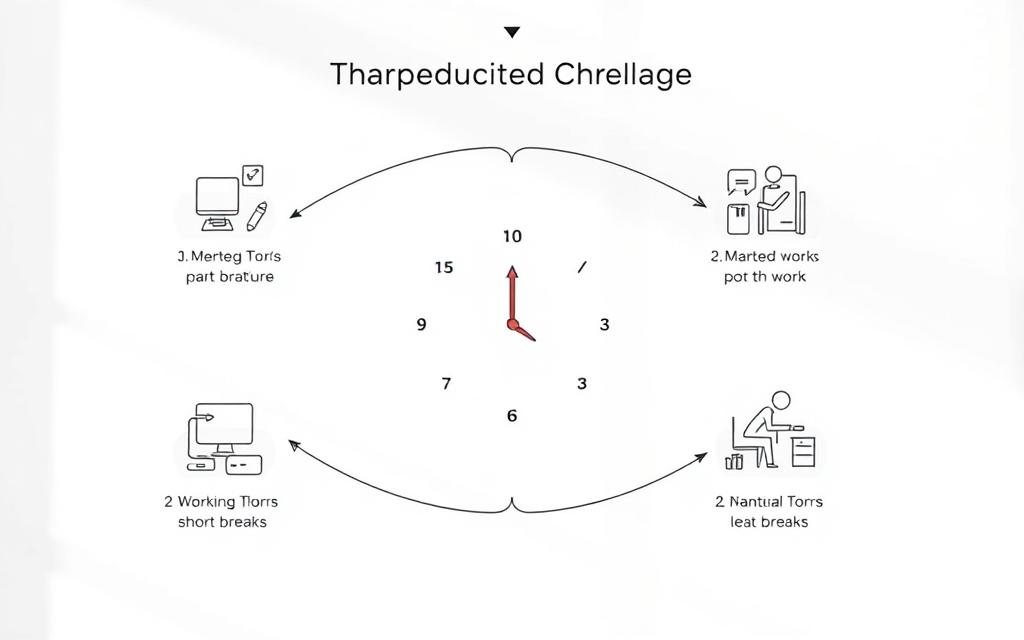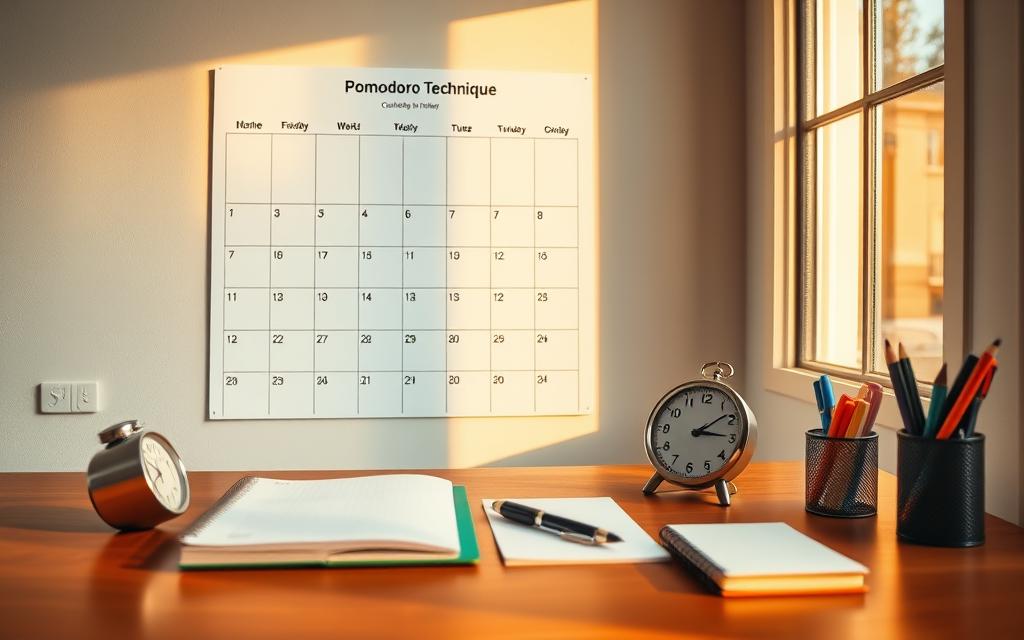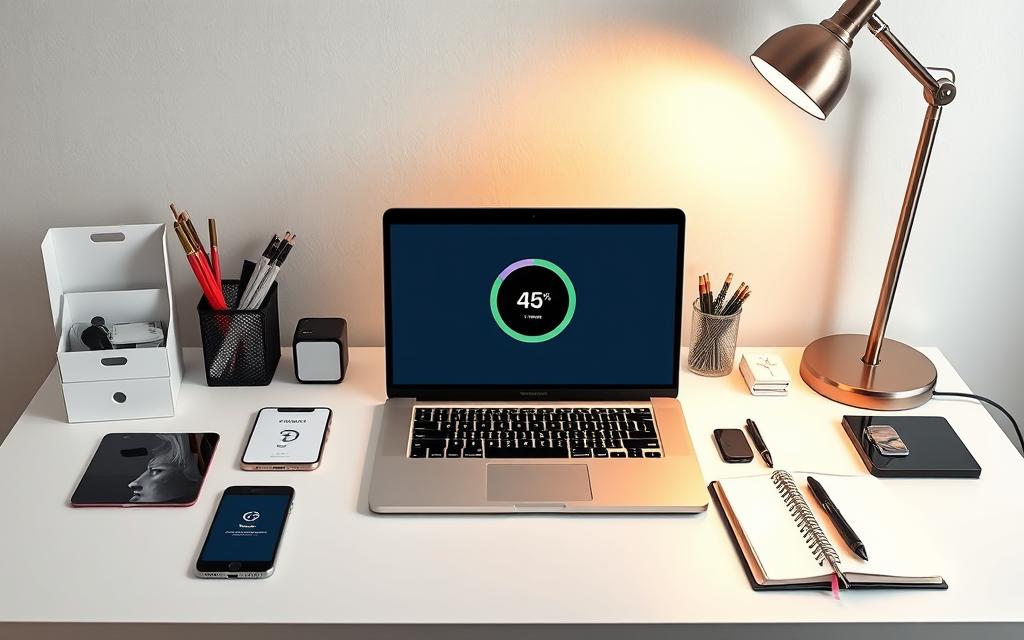Ever feel overwhelmed by endless tasks? Imagine a simple strategy that turns chaotic workdays into structured sprints. Developed by Francesco Cirillo in the late 1980s, this approach uses a unique tomato-shaped timer to divide effort into bite-sized chunks. Its beauty lies in balancing focus with recovery—like a workout for your brain.
Here’s how it works: Work for 25 minutes, then take a 5-minute break. Repeat this cycle four times before a longer pause. This rhythm combats procrastination by making big projects feel manageable. No magic required—just a timer and commitment.
In this guide, you’ll learn to customize intervals for your workflow, set up distraction-free zones, and adapt the method for team settings or creative work. Whether you’re tackling spreadsheets or art, it’s a flexible way to boost productivity without burnout.
Ready to reclaim your schedule? Let’s dive into the tools and tweaks that make this system work—for you.
What is the Pomodoro Technique?
Need a structured approach to your tasks? This productivity method uses timed sessions to transform how you tackle daily goals. Born from creative experimentation, it’s designed to sharpen focus while preventing mental fatigue.
History and Origins
Francesco Cirillo crafted this system in 1987 while studying. He tested short work intervals using a tomato-shaped kitchen timer—hence the Italian word “pomodoro” in its name. Early trials involved 2-minute bursts, but he found 25-minute spans struck the perfect balance between concentration and stamina.

The Core Process Explained
Follow five simple steps to implement the strategy:
- Choose a task: Prioritize one objective.
- Set a timer for 25 minutes.
- Work without distractions until the alarm sounds.
- Mark progress with a checkmark.
- Take a 5-minute pause, then repeat.
After four cycles, enjoy a 15-30 minute break. This rhythm trains your brain to dive deep into projects while reducing burnout. Many find it adapts well to computer-based jobs or creative workflows.
Mastering the Pomodoro Technique in Daily Life
Ready to tailor your time management? Start with your surroundings. A well-organized workspace and smart timer choices lay the foundation for focused work sessions. Let’s explore how to create your ideal setup.
Designing Your Focus Zone
Clear your desk of clutter and silence phone notifications before starting. Use noise-canceling headphones or a “do not disturb” sign to minimize interruptions. Pair this with a reliable timer—apps like Focus Keeper offer progress tracking, while old-school kitchen timers add tactile satisfaction.

Adjusting Your Rhythm
The standard 25/5 split works for many, but don’t hesitate to experiment. Try these adjustments:
- Deep work days: 45-minute sessions with 15-minute breaks
- Light tasks: 20 minutes followed by 7-minute pauses
- Creative blocks: 10-minute sprints to spark momentum
Francesco Cirillo’s original concept evolved because structured intervals need flexibility. Track your energy levels for a week—you might discover afternoon tasks take longer than morning ones. One graphic designer found 90-minute morning sessions with 20-minute breaks tripled her output!
Remember: The goal is sustainable focus, not rigid rules. Test different combinations until your workflow feels natural. Your ideal rhythm might change weekly—and that’s perfectly okay.
Practical Applications and Productivity Tips
Struggling to maintain momentum during busy days? Small adjustments to your routine can transform scattered efforts into consistent progress. Whether you’re coding, writing, or managing projects, pairing intentional habits with smart tools keeps you on track.

Using Apps and Tools for Focused Work
Digital timers like Focus Keeper (iOS) and Be Focused (Android) automate your intervals. These apps track streaks, mute notifications, and sync across devices. For creative workflows, try Forest—it grows virtual trees during sessions, turning productivity into a game.
Strategies for Overcoming Common Distractions
Combat digital interruptions with app blockers like Freedom or Cold Turkey. Schedule breaks to physically step away from screens—walk outside or stretch. One developer found closing Slack during 25-minute sprints reduced context-switching by 60%.
Integrating the Method into Different Work Environments
At home: Use smart lights to signal focus periods. In offices: Communicate your schedule with coworkers via shared calendars. For teams: Try synchronized breaks using tools like TomatoTimer. A marketing team reported 30% fewer meeting overlaps after adopting shared intervals.
Productivity articles suggest planning sessions the night before. Customize lengths based on task complexity—try 45-minute deep work blocks for heavy projects. Always honor longer breaks to recharge mental stamina.
Conclusion
Looking for a smarter way to tackle your day? This time management strategy balances effort with recovery, turning chaos into progress. Born from a student’s kitchen timer experiment, it’s evolved into a customizable system for anyone juggling deadlines or creative blocks.
At its core: short sprints of focused work paired with regular breaks. Whether you prefer 25-minute sessions or adjusted intervals, the rhythm prevents burnout while boosting output. Tools like app timers or noise-canceling headphones help maintain momentum.
Remember—success lies in personalization. Test workspace setups, tweak session lengths, and track what fuels your energy. One writer doubled her output using 45-minute morning sprints, while a coding team slashed distractions by syncing breaks.
Ready to transform how you manage tasks? Explore this structured time management approach and adapt its principles to your rhythm. Small changes today can unlock lasting productivity—and more time for what truly matters.
